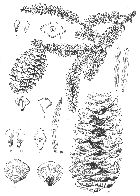
Line drawing; for full size image go to the Flora of China (Wu and Raven 1999).
Range of P. wilsonii and several other widespread Asian spruces (redrawn from Vidakovic 1991).

Line drawing; for full size image go to the Flora of China (Wu and Raven 1999).
Range of P. wilsonii and several other widespread Asian spruces (redrawn from Vidakovic 1991).
Picea wilsonii
青扦 qing qian [Chinese].
Syn.: Picea mastersii Mayr; P. watsoniana Masters; P. wilsonii var. shanxiensis Silba; P. wilsonii var. watsoniana (Masters) Silba (Wu and Raven 1999).
Trees to 50 m tall and 130 cm dbh, with a pyramidal crown. Bark gray, irregularly flaking. Branchlets yellowish green or yellowish gray, turning pale gray or brownish gray; glabrous. Leaves directed forward on upper side of branchlets, spreading on lower side, quadrangular-linear, straight or slightly curved, broadly quadrangular in cross section, 8-13×1.2-1.7 mm, with 4-5 stomatal lines along each surface; apex acuminate. Seed cones maturing yellow-brown, ovoid, 5-8×2.5-4 cm. Seed scales obovate, 14-17×10-14 mm, exposed part not striate, apex variable. Seeds obovoid, 3-4 mm, with an 8-11 mm pale brown wing. Pollination April, seed maturity October (Wu and Raven 1999).
China: Gansu, Hebei, Hubei, Nei Mongol, Qinghai, Shaanxi, Shanxi, Sichuan; at 1400-2800 m elevation (Wu and Raven 1999). Hardy to Zone 5 (cold hardiness limit between -28.8°C and -23.3°C) (Bannister and Neuner 2001).
The oldest reported living tree was 200 years old (crossdated) in 2006, growing on Yuzhong in Gansu at 2600 m elevation (Liu et al. 2019, citing Wang et al. 2006).
Used for afforestation and as an ornamental. The timber is used for furniture, construction, and pulp (Wu and Raven 1999).
The epithet honors the collector, Ernest Henry Wilson (1876-1930), famous east Asian plant-hunter in the "Indiana Jones" tradition (except he was known as "Chinese Wilson"); he wrote a number of engaging books about his adventures, such as A Naturalist in Western China. Rehder (1930) remembers, "he was a born plant collector; endowed with a strong physique, robust health, indomitable will power and a deep love of plants he succeeded in collecting and introducing into cultivation a greater number of plants than any other collector."
Liu, Jiajia, Bao Yang, and David B Lindenmayer. 2019. The oldest trees in China and where to find them. Frontiers in Ecology and the Environment 17(6): 319–22. https://doi.org/10.1002/fee.2046.
Masters, M. T. 1903. Chinese Conifers. Gardeners Chronicle ser. 3. 33:133. Available: Biodiversity Heritage Library, accessed 2020.11.28 (includes photo and drawing).
Rehder, Alfred. 1930. Ernest Henry Wilson. Journal of the Arnold Arboretum 11(4):180-192. Available: Biodiversity Heritage Library, accessed 2020.11.28 (includes photo).
Wang Y., Gou X., Liu P., and Chen F. 2006. Change of spring temperature in Yuzhong of Gansu Province during recent 200 years. Journal of Desert Research 26(2):283-285.
Last Modified 2023-10-31